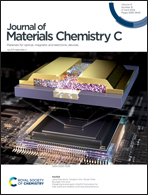[001]-Oriented heteroepitaxy for fabricating emissive surface mounted metal–organic frameworks†
Abstract
Well-oriented growth of surface-anchored metal–organic frameworks (SURMOFs) makes them ideal candidates for optical sensor applications. In this work, SURMOF bilayers and trilayers that exhibit [001] orientation are formed via heteroepitaxial growth. Using liquid-phase epitaxy (LPE), a 〈100〉 silicon substrate is alternatingly exposed to a solution of metal salts and organic linkers. A Cu2(BDC)2(DABCO) basis layer allows subsequent deposition of Zn2(BDC)2(DABCO) with 93% of the material aligned in the crystallographic [001] orientation. This is not possible without a Cu-SURMOF seed layer. Out-of-plane X-ray diffraction, 2D grazing-incidence wide-angle X-ray scattering, and scanning electronic microscopy techniques reveal that the hybrid SURMOFs display oriented island-type film growth, resulting in multishell islands. A third oriented SURMOF Zn2(ADC)2(BPy) can be added to endow the heterostructure with photoluminescence, which is not quenched by the Cu-SURMOF due to the intermediate Zn2(BDC)2(DABCO) layer. Conceptually, the step-by-step LPE deposition method allows the construction of monolithic multilayer SURMOFs wherein the orientation can be controlled by well-behaved templating layers and functionality can be added by more exotic layers that are challenging to grow on their own.
![Graphical abstract: [001]-Oriented heteroepitaxy for fabricating emissive surface mounted metal–organic frameworks](/en/Image/Get?imageInfo.ImageType=GA&imageInfo.ImageIdentifier.ManuscriptID=D4TC00018H&imageInfo.ImageIdentifier.Year=2024)


 Please wait while we load your content...
Please wait while we load your content...